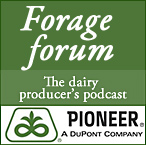The new Milk 2006 equation for silage corn from the University of Wisconsin reflects important modifications to the Milk 2000 version, according to Dr. Bill Mahanna, coordinator of global nutritional sciences for Pioneer Hi-Bred. Neutral digestive fiber (NDF) values can now be entered from any time point. Milk 2000 accommodated only a 48-hour value. Also, starch digestibility values can now … Read More
Why’s and What-For’s of VFA Profiles
Why has interest increased in testing for volatile fatty acid (VFA) profiles in silages? Because nutritionists are looking for ways to better fine-tune rations, and because laboratories have responded with advanced technologies in testing for VFA’s. Dr. Bill Mahanna, coordinator of global nutritional sciences for Pioneer Hi-Bred, provides a brief refresher on VFA’s. Citing Pioneer research, he offers observations on … Read More
Shifting the Blame for Milk Butterfat Depression
Conventional wisdom has linked milk butterfat depression mostly to low fiber content. Theories on what creates this problem are now shifting, says Dr. Bill Mahanna, coordinator of global nutritional sciences for Pioneer Hi-Bred. Studies indicate that as a result of higher-energy silage corn rations, trans-fatty acids from oils in forages and grains may account for much of this depression. The … Read More
Vitreousness: Hard Facts Lead to Softened Concerns
Among silage corn issues, vitreousness generates more noise than it deserves, says Dr. Bill Mahanna, coordinator of global nutritional sciences for Pioneer Hi-Bred. This is the hard starch on the outside of the corn kernel that develops late in maturity, contributing to high test weight. Bill says research based solely on dry corn at 15.5% moisture is not relevant to … Read More
Accurate Analysis Begins with Smart Sampling
 At what point can inaccuracies plague the testing of corn silage? The greater potential for problems is not in the laboratory, but instead in the sampling, according to Dr. Bill Mahanna, coordinator of global nutritional sciences for Pioneer Hi-Bred. Because analysis can be no better than the samples themselves, Bill offers suggestions for performing steps safely and effectively, from acquisition to preservation to shipment. This includes alternative methods when the “magic number of 12” samples isn’t practical.
At what point can inaccuracies plague the testing of corn silage? The greater potential for problems is not in the laboratory, but instead in the sampling, according to Dr. Bill Mahanna, coordinator of global nutritional sciences for Pioneer Hi-Bred. Because analysis can be no better than the samples themselves, Bill offers suggestions for performing steps safely and effectively, from acquisition to preservation to shipment. This includes alternative methods when the “magic number of 12” samples isn’t practical.
Fresh Measurements of Your Next Feed Crop
Smooth transition to a new feed crop starts with analysis per back-to-basics guidelines. For example, separate the evaluations between the grass portion of your corn and the high- moisture grain. Open your mind, though, to new strategies, advises Dr. Bill Mahanna, coordinator of global nutritional sciences for Pioneer Hi-Bred. New testing methods are providing valuable information on degree of kernel … Read More
Snaplage Makes Sense for High-Moisture Harvest
While harvesting snaplage is not a new practice, it is becoming more appealing, says Dr. Bill Mahanna, coordinator of global nutritional services for Pioneer Hi-Bred. A leading reason is the advent of new, large silage choppers utilizing snapper heads with kernel processors. Primary benefits are improved tonnage with very good digestible fiber and high kernel starch. Pioneer has recently completed … Read More
What to Demand from Data
Experts agree on the basics for believability in corn silage plot data. Dr. Bill Mahanna, coordinator of global nutritional services for Pioneer Hi-Bred, details credibility thresholds for confidence in that data. He also clarifies the seven most relevant categories of silage corn data, including which ones he believes are most revealing for comparison of genetics. Supported by university studies, Bill … Read More
Shared Expectations for Better Corn Silage
 An up-front dialogue between the nutritionist and custom cutter can pay dividends, says Dr. Bill Mahanna, coordinator of global nutritional sciences for Pioneer Hi-Bred. A nutritionist’s ration plans can change year-to-year, so variables such as length of chop and degree of processing should be adjusted accordingly. If the nutritionist shows desirable corn silage samples to the custom cutter and clarifies needs in advance, it diminishes subjectivity and improves everyone’s satisfaction. Bill has suggestions for encouraging this face-to-face planning. Listen to them and tell Bill your experiences.
An up-front dialogue between the nutritionist and custom cutter can pay dividends, says Dr. Bill Mahanna, coordinator of global nutritional sciences for Pioneer Hi-Bred. A nutritionist’s ration plans can change year-to-year, so variables such as length of chop and degree of processing should be adjusted accordingly. If the nutritionist shows desirable corn silage samples to the custom cutter and clarifies needs in advance, it diminishes subjectivity and improves everyone’s satisfaction. Bill has suggestions for encouraging this face-to-face planning. Listen to them and tell Bill your experiences.
Reality-Driven Pricing for Corn Silage
 Should the cost of purchasing corn silage be driven by quantity or quality? Dr. Bill Mahanna, coordinator of global nutritional sciences for Pioneer Hi-Bred, believes in retiring the 30-year-old rule of thumb, the Board of Trade price for corn times six or seven. Current lab methods and credible indexes are more accurate in determining relative values to dairy operators and fairly compensating silage growers. Bill details various pricing opportunities in a spreadsheet, which he’s willing to share. For a copy, e-mail him at bill.mahanna@pioneer.com.
Should the cost of purchasing corn silage be driven by quantity or quality? Dr. Bill Mahanna, coordinator of global nutritional sciences for Pioneer Hi-Bred, believes in retiring the 30-year-old rule of thumb, the Board of Trade price for corn times six or seven. Current lab methods and credible indexes are more accurate in determining relative values to dairy operators and fairly compensating silage growers. Bill details various pricing opportunities in a spreadsheet, which he’s willing to share. For a copy, e-mail him at bill.mahanna@pioneer.com.
